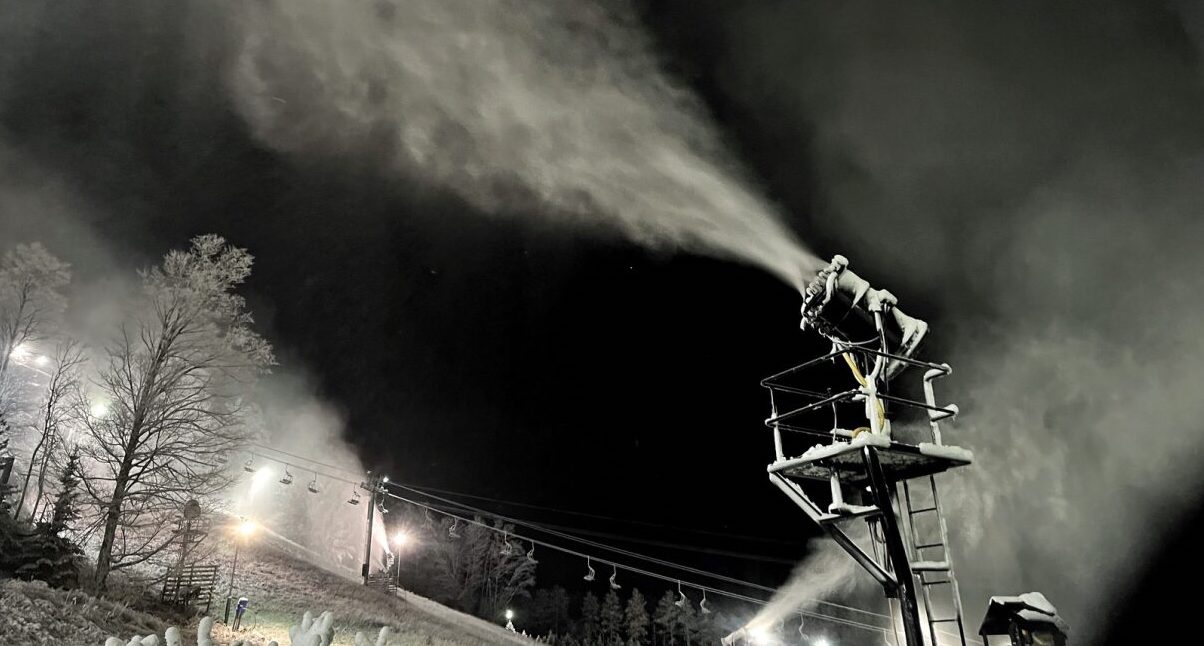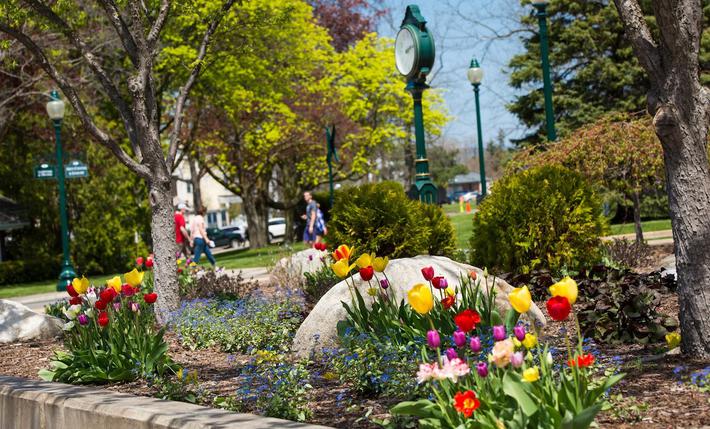
The Cost of Ski Season, From Staffing to Snowmaking and Everything in Between
Northern Michigan ski resorts share their financial impact and future plans in the face of uncertain winters
By Art Bukowski | Dec. 16, 2023
When’s the last time you hit the slopes?
Each season, hundreds of thousands of people visit the dozen northern Michigan ski hills that stretch from Cadillac up to Harbor Springs, and the majority of those skiers come from downstate or farther still. This big rush of folks eager to carve their way downhill makes for a powerful economic impact.
There’s the revenue for the resorts themselves, of course, which employ thousands of people. (Crystal Mountain, Shanty Creek, and Boyne USA are the largest employers in Benzie, Antrim, and Charlevoix counties, respectively.) Then there’s the money that trickles into local restaurants, bars and shops, along with the ample amount of work sent to local contractors to support skiing operations.
But while they have no plans of slowing down, local resorts have an eye on changing climate, increased costs, and other concerns that might lead to a change in the way they do business.
Downhill Dollars
Shanty Creek’s Schuss Mountain, along with its other properties, are a stone’s throw from Bellaire, Antrim County’s largest community. Leaders at Shanty make an active effort to direct folks into Bellaire, which they feel only adds to the fun of an up north ski trip.
“We feel really strongly that Bellaire is part of the Shanty Creek experience, so much so that we actually do shuttle stops into Bellaire every day,” says Lindsey Southwell, Shanty’s director of marketing. “Because we’re not so bold to think that someone comes to a resort and they only want to stay here, right? Part of the experience is checking out the area, and obviously there are a lot of cool things to do in town.”
Southwell is also president of Bellaire’s chamber of commerce, and she can attest to the value those Shanty Creek visitors bring. They have roughly 100,000 skier visits a year, which translates to a lot of Bellaire business. As much as 90 percent of these visitors in an average year are from out of town, Southwell says.
Over at Treetops Resort, general manager Barry Owens points out that nearly everyone who arrives at his slopes will pass through Gaylord, which sits along I-75 just a few miles west. He estimates that at least 75 percent of his skiers are from out of town.
“[We have] what I would call a significant impact with skiers that are coming to our region and contributing to the overall economy in the area, whether it’s a dinner, or shopping, or a tank of gas, or whatever it may be,” he says. “And then even another level is the skiers that don’t stay with us and instead stay in Airbnbs or Vrbos or hotels in the area, too.”
It’s more than just the skiers themselves that provide a boost to the local economy. Thousands of people are employed in the ski industry throughout northern Michigan, the vast majority of them local. Crystal Mountain in Thompsonville is not only the biggest employer in Benzie County, but one of the largest private employers in the entire region.
“We’re over 700 people during winter operations and about 550 in summer operations. So we do well over 1,000 W-2s on an annual basis,” says CEO John Melcher. “We’ve got quite a few people that depend on this business to provide for their families, and I think that’s a huge component [of our impact]. From my seat, I think about all our staff and the families that depend on us being successful.”
Mechler was quick to point out the large amount of money that also flows from Crystal to dozens of local businesses.
“We’re a capital-intensive business, labor-intensive business. We certainly support a lot of other businesses, whether it’s our HVAC partners or the whole fleet of vehicles that we’re purchasing and maintaining,” he says. “There’s a lot of economic impact as far as what we’re spending to keep our operations going and keep everything powered up.”
The ski resorts also serve as a gateway of sorts to all sorts of northern Michigan activities, spreading the economic love far and wide.
“We’re a destination that folks can use as a home base; they can stay in our lodging and explore the region. We’re an hour and change from the bridge, so we’re not too far from the Upper Peninsula or Mackinaw City,” says Jason Perl, general manager of Boyne Mountain. “So you can come up here and ski or golf or do the water park and still have all these other amazing places within a couple hours to visit. It’s a great home base for day trips.”
Making Snow to Make Ends Meet
Ski season may be a boon to our towns and residents, but the ups and downs of the last few years—including the pandemic, recent inflation, and tricky snow conditions—have caused a ripple effect.
For example, lift ticket and season pass prices have risen considerably over the past 15 years, now topping $100 (with taxes and fees) at some local resorts for a single Saturday on the slopes. But the costs of doing business have shot up too; expenses tied to labor, energy, maintenance, and more continue to put the pinch on area resorts.
And while uneven weather patterns have yet to cause significant problems for northern Michigan resorts, the industry as a whole is bracing for the long-term effects of climate change. Making snow is far from cheap—the guns themselves cost tens of thousands of dollars—and warmer weather is likely to upset the careful balance of man-made and natural snow that ski resorts need to stay in the black.
“Snowmaking is the most expensive part of ski operations. There’s a ton of energy costs with pumping the millions of gallons of water that we do,” Shanty Creek’s Southwell says. “We really try to capitalize on snowmaking at the appropriate time. There is a certain time, just in general, where it’s no longer profitable to make snow. You can make snow all winter long if you want to, but there’s a point where it’s just not profitable anymore because you’re never going to recoup those costs.”
Warmer temperatures and less natural snow are not ideal, managers say, but they can be mitigated somewhat by diligent snowmaking and grooming. Plus, having the ability to make snow artificially via their network of snow guns might even be a draw to the slopes.
“A lot of times, we might be the only option to get out on the snow when there’s not snowmobiling in the area or cross-country skiing out in the woods,” Treetops’ Owens says.
All the resorts can do is hope for the best while preparing for the worst. Part of that preparation includes investing in the latest snow gun technology, which has improved significantly in recent decades.
“Every year we’re continuing to invest in our snowmaking infrastructure. We’ve got a robust plan, but it can always be better,” Crystal Mountain’s Melcher says. “We want to be able to turn it on and go full force even if we’ve got just a few hours in which to get it done.”
Boyne Mountain’s Perl says his resort hopes to soon have the “most comprehensive, efficient and powerful snowmaking system in Michigan.”
“A lot of ski resorts are upgrading their snowmaking efficiency and capabilities, and we’re in the midst of a multi-year snowmaking master plan to bring our system into the future,” he says. “How much snow can we make in the shortest amount of time? If we only got seven days the whole season, could we open all the trails?”
Maintaining Focus, Building Resiliency
One of the most unusual problems with warmer winters is getting people to still come skiing, Melcher says. Ski resorts are capable of producing and maintaining snow long after it’s vanished elsewhere, but by the time that happens, many hearts and minds have moved past skiing.
“[Last year] we made snow well into March, just to keep the slopes open, and we actually had really good ski conditions. But the challenge was that even though we had great conditions on our slopes, people are looking out their back window and can see grass,” he says. “We and all the other ski resorts were trying to message people, particularly downstate, that hey, even if it looks like spring at your door, winter is here and well.”
Another prong of resiliency plans for local resorts includes beefing up all the other revenue generators that aren’t tied to the slopes.
“Over the last 30 years, we’ve been building out a very robust spring, summer, and fall business with the two golf courses. And we’ve got a conference center and outdoor water park, we’ve got a great spa that’s always busy. The idea there is to have some things to make us more resilient for difficult weather in the wintertime,” Melcher says. “We’re also finding weird weather patterns in the summer, so having this year-round flow of things for people to do with outdoor recreation really kind of inoculates us from weather problems in any season.”
“I think we all continue to look at different things that can supplement or replace,” Treetops’ Owens says. “There’s places messing around with indoor skiing on carpets, but are we contemplating that in our forward capital plan at this time? We are not. We still feel that the foreseeable future is good in regards to the ability to do what we do here for the winter season. But it’s something we and the industry continue to monitor.”
Trending

Lakeside Weekend Adventures
The little lakeside corner of the world made up of Bay Harbor, Petoskey, Walloon Lake, and Harbor Springs is always full o... Read More >>
What to Do This Memorial Day Weekend, from Parades to BBQs to Concerts
Memorial Day Weekend, a time to honor and remember those who have served and fallen in the United States Armed Forces, has... Read More >>
A Birder's Paradise
The Beaver Island Birding Trail celebrates its annual Birding Foray May 24-26. The weekend consists of multiple field trip... Read More >>


